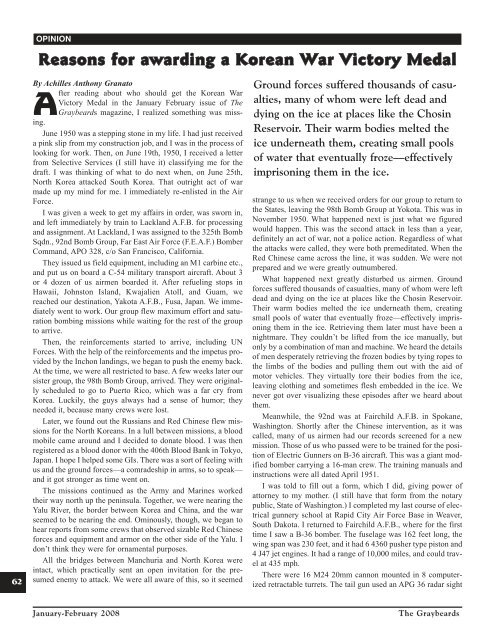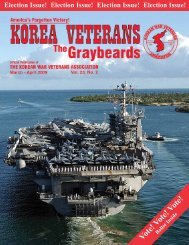Jan/Feb 2008 - KWVA - Korean War Veterans Association
Jan/Feb 2008 - KWVA - Korean War Veterans Association
Jan/Feb 2008 - KWVA - Korean War Veterans Association
You also want an ePaper? Increase the reach of your titles
YUMPU automatically turns print PDFs into web optimized ePapers that Google loves.
62<br />
OPINION<br />
Reasons for awarding a <strong>Korean</strong> <strong>War</strong> Victory Medal<br />
By Achilles Anthony Granato<br />
After reading about who should get the <strong>Korean</strong> <strong>War</strong><br />
Victory Medal in the <strong>Jan</strong>uary <strong>Feb</strong>ruary issue of The<br />
Graybeards magazine, I realized something was missing.<br />
June 1950 was a stepping stone in my life. I had just received<br />
a pink slip from my construction job, and I was in the process of<br />
looking for work. Then, on June 19th, 1950, I received a letter<br />
from Selective Services (I still have it) classifying me for the<br />
draft. I was thinking of what to do next when, on June 25th,<br />
North Korea attacked South Korea. That outright act of war<br />
made up my mind for me. I immediately re-enlisted in the Air<br />
Force.<br />
I was given a week to get my affairs in order, was sworn in,<br />
and left immediately by train to Lackland A.F.B. for processing<br />
and assignment. At Lackland, I was assigned to the 325th Bomb<br />
Sqdn., 92nd Bomb Group, Far East Air Force (F.E.A.F.) Bomber<br />
Command, APO 328, c/o San Francisco, California.<br />
They issued us field equipment, including an M1 carbine etc.,<br />
and put us on board a C-54 military transport aircraft. About 3<br />
or 4 dozen of us airmen boarded it. After refueling stops in<br />
Hawaii, Johnston Island, Kwajalien Atoll, and Guam, we<br />
reached our destination, Yakota A.F.B., Fusa, Japan. We immediately<br />
went to work. Our group flew maximum effort and saturation<br />
bombing missions while waiting for the rest of the group<br />
to arrive.<br />
Then, the reinforcements started to arrive, including UN<br />
Forces. With the help of the reinforcements and the impetus provided<br />
by the Inchon landings, we began to push the enemy back.<br />
At the time, we were all restricted to base. A few weeks later our<br />
sister group, the 98th Bomb Group, arrived. They were originally<br />
scheduled to go to Puerto Rico, which was a far cry from<br />
Korea. Luckily, the guys always had a sense of humor; they<br />
needed it, because many crews were lost.<br />
Later, we found out the Russians and Red Chinese flew missions<br />
for the North <strong>Korean</strong>s. In a lull between missions, a blood<br />
mobile came around and I decided to donate blood. I was then<br />
registered as a blood donor with the 406th Blood Bank in Tokyo,<br />
Japan. I hope I helped some GIs. There was a sort of feeling with<br />
us and the ground forces—a comradeship in arms, so to speak—<br />
and it got stronger as time went on.<br />
The missions continued as the Army and Marines worked<br />
their way north up the peninsula. Together, we were nearing the<br />
Yalu River, the border between Korea and China, and the war<br />
seemed to be nearing the end. Ominously, though, we began to<br />
hear reports from some crews that observed sizable Red Chinese<br />
forces and equipment and armor on the other side of the Yalu. I<br />
don’t think they were for ornamental purposes.<br />
All the bridges between Manchuria and North Korea were<br />
intact, which practically sent an open invitation for the presumed<br />
enemy to attack. We were all aware of this, so it seemed<br />
Ground forces suffered thousands of casualties,<br />
many of whom were left dead and<br />
dying on the ice at places like the Chosin<br />
Reservoir. Their warm bodies melted the<br />
ice underneath them, creating small pools<br />
of water that eventually froze—effectively<br />
imprisoning them in the ice.<br />
strange to us when we received orders for our group to return to<br />
the States, leaving the 98th Bomb Group at Yokota. This was in<br />
November 1950. What happened next is just what we figured<br />
would happen. This was the second attack in less than a year,<br />
definitely an act of war, not a police action. Regardless of what<br />
the attacks were called, they were both premeditated. When the<br />
Red Chinese came across the line, it was sudden. We were not<br />
prepared and we were greatly outnumbered.<br />
What happened next greatly disturbed us airmen. Ground<br />
forces suffered thousands of casualties, many of whom were left<br />
dead and dying on the ice at places like the Chosin Reservoir.<br />
Their warm bodies melted the ice underneath them, creating<br />
small pools of water that eventually froze—effectively imprisoning<br />
them in the ice. Retrieving them later must have been a<br />
nightmare. They couldn’t be lifted from the ice manually, but<br />
only by a combination of man and machine. We heard the details<br />
of men desperately retrieving the frozen bodies by tying ropes to<br />
the limbs of the bodies and pulling them out with the aid of<br />
motor vehicles. They virtually tore their bodies from the ice,<br />
leaving clothing and sometimes flesh embedded in the ice. We<br />
never got over visualizing these episodes after we heard about<br />
them.<br />
Meanwhile, the 92nd was at Fairchild A.F.B. in Spokane,<br />
Washington. Shortly after the Chinese intervention, as it was<br />
called, many of us airmen had our records screened for a new<br />
mission. Those of us who passed were to be trained for the position<br />
of Electric Gunners on B-36 aircraft. This was a giant modified<br />
bomber carrying a 16-man crew. The training manuals and<br />
instructions were all dated April 1951.<br />
I was told to fill out a form, which I did, giving power of<br />
attorney to my mother. (I still have that form from the notary<br />
public, State of Washington.) I completed my last course of electrical<br />
gunnery school at Rapid City Air Force Base in Weaver,<br />
South Dakota. I returned to Fairchild A.F.B., where for the first<br />
time I saw a B-36 bomber. The fuselage was 162 feet long, the<br />
wing span was 230 feet, and it had 6 4360 pusher type piston and<br />
4 J47 jet engines. It had a range of 10,000 miles, and could travel<br />
at 435 mph.<br />
There were 16 M24 20mm cannon mounted in 8 computerized<br />
retractable turrets. The tail gun used an APG 36 radar sight<br />
<strong>Jan</strong>uary-<strong>Feb</strong>ruary <strong>2008</strong><br />
The Graybeards
















